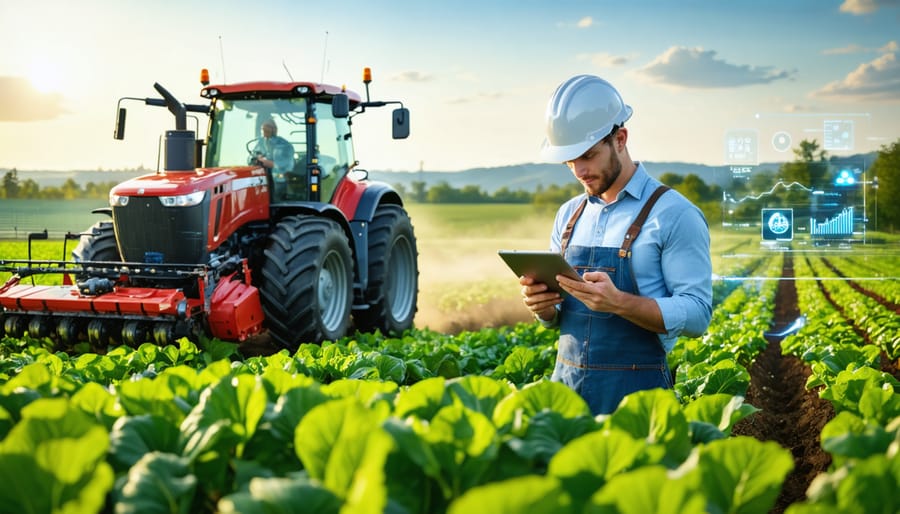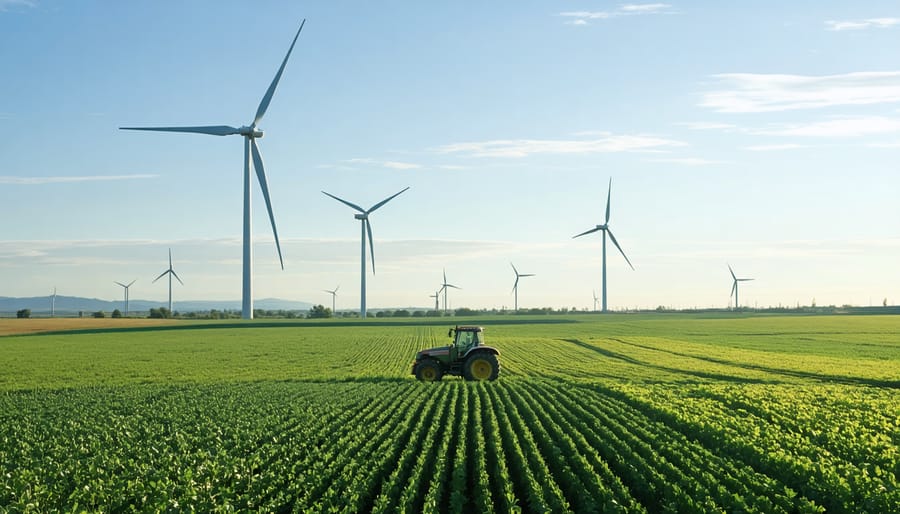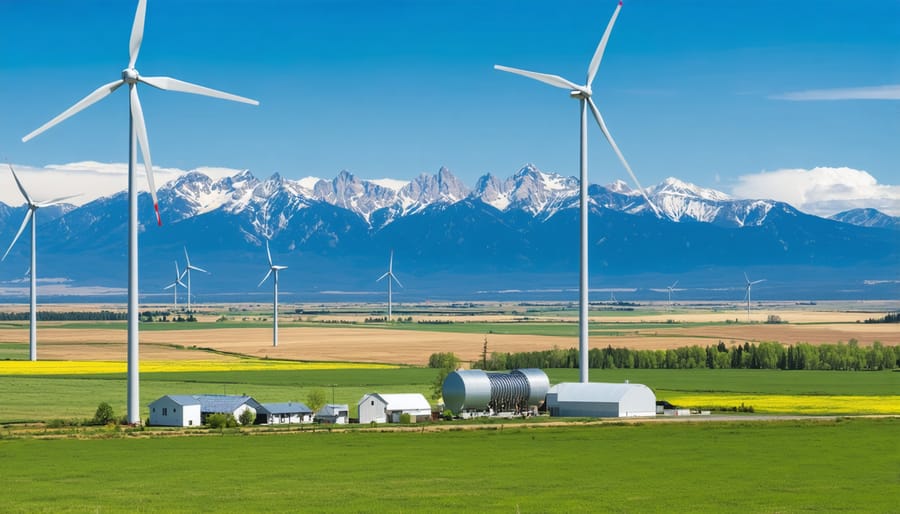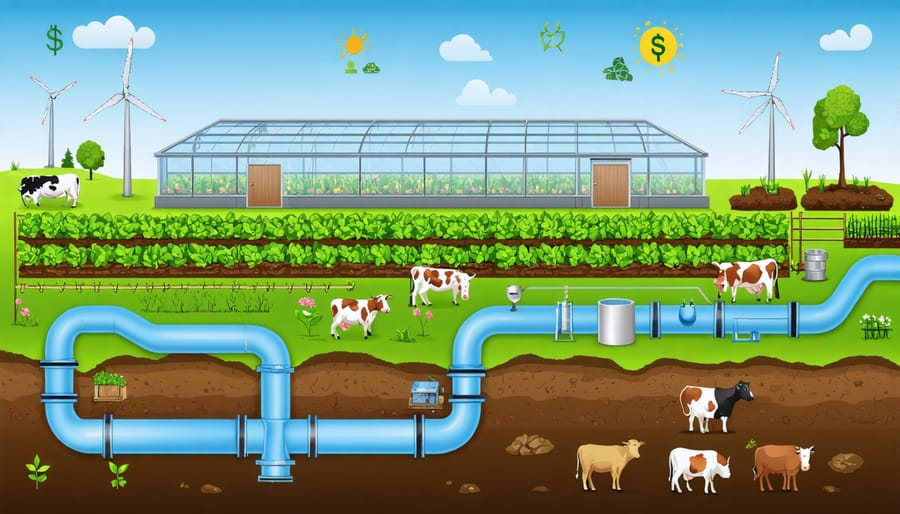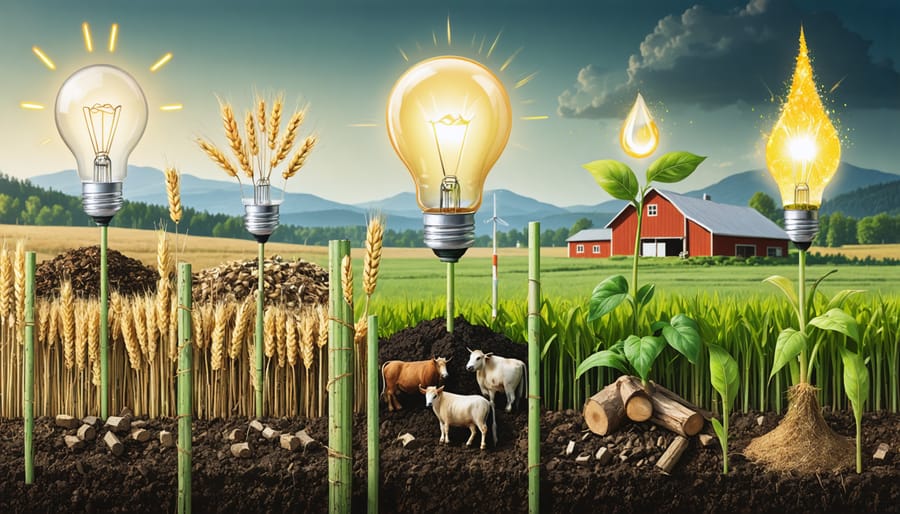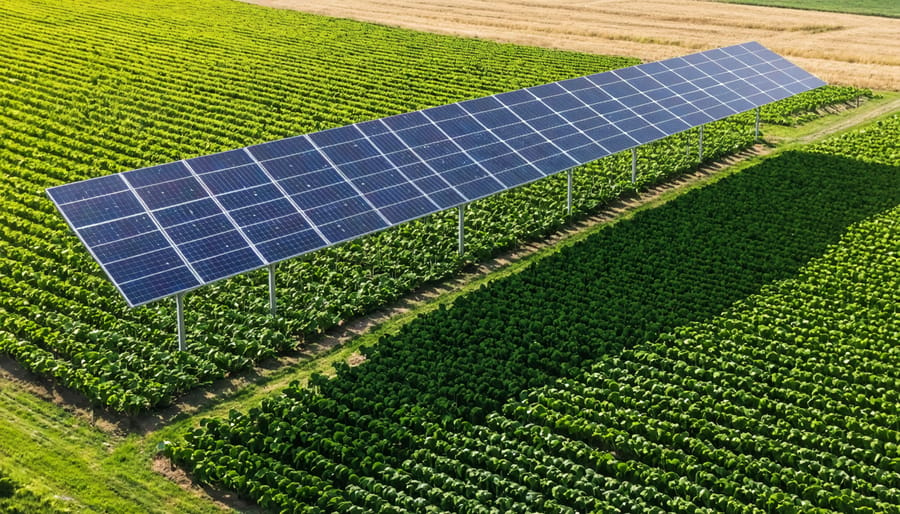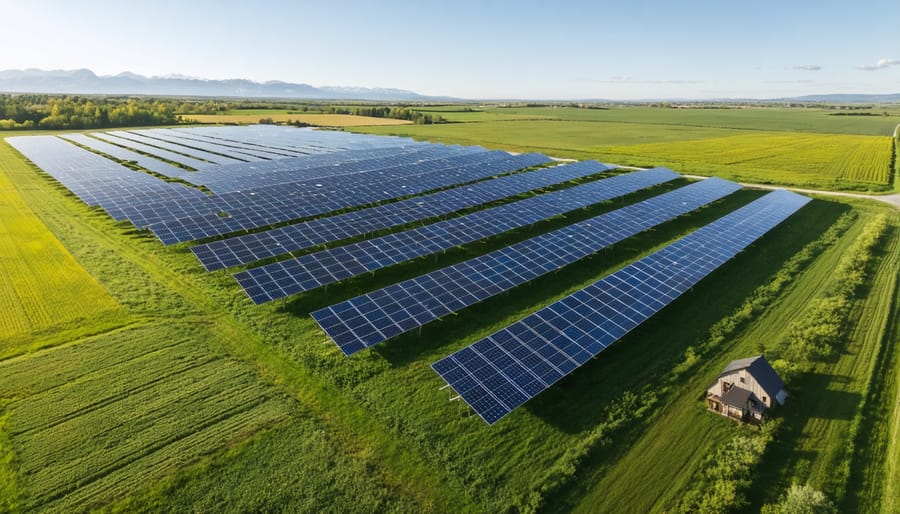Precision agriculture technology transforms Canadian farms by slashing energy costs up to 30% while boosting crop yields through data-driven decision making. GPS-guided tractors reduce fuel consumption and field overlap by 15%, while smart irrigation systems optimize water usage based on real-time soil moisture data. Integrated renewable energy solutions and automated equipment management systems help Alberta farmers maintain peak operational efficiency even during unpredictable weather patterns.
Today’s precision farming combines satellite mapping, IoT sensors, and artificial intelligence to create detailed field prescriptions that optimize resource allocation across every hectare. These technologies deliver precise insights about soil conditions, crop health, and equipment performance, enabling farmers to make data-backed decisions that maximize productivity while minimizing environmental impact.
As Canadian agriculture evolves to meet growing sustainability demands, precision technology offers a practical path forward. Modern farms using these systems report 20% lower input costs alongside improved crop quality and reduced soil compaction. For Alberta’s agricultural community, these innovations represent not just cost savings, but a more resilient and sustainable future for family farms.
How Precision Agriculture Technology Transforms Energy Use
GPS and Auto-Steering Systems
GPS and auto-steering systems have revolutionized farming practices across Alberta and beyond, offering significant energy savings through precise field navigation. These systems eliminate overlapping passes in the field, reducing fuel consumption by up to 10% and minimizing unnecessary equipment operation time.
Modern auto-steering technology can maintain accuracy within 2.5 centimetres, ensuring optimal spacing between rows and preventing double-seeding or missed spots. Calgary-based farmer Jim Thompson reports saving nearly 2,000 litres of fuel annually since implementing GPS guidance on his 2,000-hectare operation.
The technology proves particularly valuable during low-visibility conditions, such as early morning seeding or late-night harvesting, when manual steering might result in costly overlap. Auto-steering systems also reduce operator fatigue, allowing for longer working hours when needed during critical planting and harvesting windows.
Many Canadian farmers find that these systems pay for themselves within two to three growing seasons through reduced input costs and improved efficiency. Integration with other precision agriculture tools, such as variable rate application systems, further enhances the energy-saving benefits of GPS technology.

Variable Rate Technology (VRT)
Variable Rate Technology revolutionizes resource management by precisely controlling the application of inputs like fertilizers, seeds, and water across different field zones. This smart system uses GPS mapping and soil data to automatically adjust application rates, ensuring optimal resource distribution while minimizing waste. Many Alberta farmers have reported 15-20% reductions in input costs after implementing VRT systems.
When integrated with solar-powered farming equipment, VRT systems become even more energy-efficient, creating a sustainable approach to precision agriculture. The technology uses real-time sensors and historical field data to create detailed application maps, allowing farmers to apply exactly what’s needed where it’s needed.
For example, the Brown family farm near Lethbridge achieved a 25% reduction in fertilizer use while maintaining yield levels by implementing VRT. The system identified areas requiring different nutrient levels and automatically adjusted application rates accordingly. This smart resource management not only reduces environmental impact but also provides significant cost savings, making it an increasingly popular choice among forward-thinking Canadian farmers.
Real-Time Monitoring Systems That Save Power
Smart Irrigation Systems
Smart irrigation systems are revolutionizing water management across Alberta’s farmlands, offering precise control over moisture levels while significantly reducing water waste and energy costs. These systems use a network of soil moisture sensors, weather monitoring stations, and automated controls to deliver water exactly when and where crops need it.
By implementing soil moisture probes at various depths, farmers can track water availability throughout the root zone, ensuring optimal growing conditions without over-irrigation. Real-time data collection allows for immediate adjustments based on current weather conditions, crop requirements, and soil moisture levels.
Many Alberta farmers have reported water savings of 20-30% after switching to smart irrigation systems. For instance, the Thompson family farm near Lethbridge reduced their water consumption by 25% while maintaining crop yields by installing variable-rate irrigation technology with GPS-guided controls.
These systems can be integrated with existing pivot irrigation infrastructure, making adoption more cost-effective. Modern smart irrigation controllers can be managed through smartphone apps, allowing farmers to monitor and adjust irrigation schedules remotely. Some systems also incorporate weather forecasting data to automatically adjust watering schedules, preventing unnecessary irrigation before predicted rainfall.
The initial investment in smart irrigation technology is often offset by reduced water and energy costs within 2-3 growing seasons. Government programs through the Canadian Agricultural Partnership may provide funding support for farmers looking to upgrade their irrigation systems to more efficient alternatives.

Equipment Performance Tracking
In modern farming operations, tracking equipment performance has become essential for optimizing energy consumption and reducing operational costs. Canadian farmers are increasingly adopting sophisticated monitoring systems that provide real-time data on fuel usage, engine performance, and operational efficiency.
These systems typically include GPS-enabled monitors that track machinery movement patterns, helping farmers identify inefficient routes or unnecessary idling time. For example, Alberta grain farmer Mike Thompson reduced his fuel consumption by 15% after implementing performance tracking on his fleet of tractors and combines.
Smart sensors installed on equipment measure key metrics like engine temperature, oil pressure, and power output. This data helps farmers schedule preventive maintenance and identify potential issues before they lead to costly breakdowns or excessive fuel consumption. Many systems also integrate with mobile apps, allowing farmers to monitor their equipment’s performance remotely.
Energy consumption patterns can be analyzed over time, revealing opportunities for improvement. Some farmers have reported savings of up to 20% on fuel costs by adjusting their equipment operation based on performance data. The technology also helps optimize implement depth and speed settings, ensuring machinery operates at peak efficiency while maintaining quality field work.
For best results, farmers should regularly review performance reports and adjust their equipment settings accordingly. Many agricultural equipment dealers in Canada now offer training sessions to help farmers maximize the benefits of their performance tracking systems.
Alberta Success Stories: Precision Tech in Action
Alberta’s farming community has been leading the charge in adopting precision agriculture technologies, with remarkable results in energy efficiency and productivity. Take the case of Sarah Henderson, a third-generation farmer near Lethbridge, who implemented GPS-guided tractors and variable rate technology to reduce fuel consumption by 25% while maintaining optimal crop yields.
The Johansen family farm in Red Deer County showcases how integrating smart irrigation systems with soil moisture sensors has cut their energy usage by 30%. Their system, connected to advanced energy storage solutions, automatically adjusts water distribution based on real-time soil conditions, saving both water and power.
Near Grande Prairie, the Martinez operation demonstrates the power of precision livestock farming. Using RFID tracking and automated feeding systems, they’ve reduced feed waste by 20% and decreased energy consumption in their barn operations by 35%. Their smart ventilation system responds to temperature and humidity changes, maintaining optimal conditions while minimizing power usage.
The Cooper Farm in Drumheller represents another success story, utilizing drone technology for crop monitoring and precise chemical application. This approach has resulted in a 40% reduction in input costs and significant energy savings from reduced equipment operation time.
These innovations aren’t limited to large operations. Small-scale farmer David Wong near Olds has implemented affordable precision technology solutions, including smartphone-based field mapping and basic automated irrigation controls, achieving a 15% reduction in energy costs during his first year.
What these success stories share is a methodical approach to technology adoption, starting with careful assessment of energy usage patterns and gradual implementation of solutions. They demonstrate that precision agriculture technology, when properly implemented, can significantly reduce energy consumption while improving farm efficiency and sustainability.
Local agricultural extension services have documented these successes, creating a knowledge-sharing network that helps other Alberta farmers learn from these experiences and implement similar solutions on their own operations.
Getting Started with Precision Energy Management

Assessing Your Farm’s Needs
Before implementing precision agriculture technology, it’s crucial to conduct a thorough assessment of your farm’s current operations and needs. Start by documenting your energy consumption patterns across all farming activities, from irrigation systems to machinery usage. Keep detailed records of fuel consumption, electricity bills, and operational hours for each piece of equipment.
Consider creating an energy audit checklist that includes key areas such as field operations, storage facilities, and processing equipment. Many Alberta farmers have found success using smart meters and monitoring systems to track real-time energy usage, helping identify peak consumption periods and potential waste areas.
Walk your fields with a critical eye, noting areas where crop yields vary or where equipment efficiency seems compromised. Map out your current technological infrastructure, including any existing GPS systems, sensors, or automated equipment. This baseline information will help you identify gaps and opportunities for improvement.
Consult with local agricultural extension services or energy advisors who can provide specialized insights for your specific operation. They can help evaluate your current practices and recommend appropriate precision technologies based on your farm’s size, crop types, and operational goals.
Remember to involve your farm team in this assessment process. Their hands-on experience can provide valuable insights into daily operational challenges and areas where precision technology could make the biggest impact.
Available Grants and Support
Canadian farmers looking to adopt precision agriculture technology have access to numerous funding opportunities through federal and provincial programs. The Canadian Agricultural Partnership (CAP) offers grants of up to $100,000 for technology adoption and sustainable farming practices. In Alberta, the Environmental Stewardship and Climate Change Producer Program provides cost-sharing opportunities of up to 70% for qualifying precision agriculture equipment.
The Agriculture Financial Services Corporation (AFSC) in Alberta offers specialized loans with competitive interest rates for purchasing precision farming technology. Farmers can also explore alternative energy funding programs that support the integration of renewable energy systems with precision agriculture equipment.
Additional support is available through the Agricultural Clean Technology Program, which provides funding for innovations that reduce greenhouse gas emissions while improving farm efficiency. The Scientific Research and Experimental Development (SR&ED) tax incentive program offers tax credits for farmers implementing new technological solutions.
Local agricultural societies and producer groups often provide matching grants and educational resources. The Farm Technology Program assists with initial consultations and implementation planning. To access these opportunities, farmers can connect with their regional agricultural fieldman or visit their local Agriculture Service Board office for application assistance and guidance.
As we’ve explored throughout this article, precision agriculture technology represents a transformative opportunity for Canadian farmers to enhance their operations while contributing to a more sustainable agricultural future. The benefits are clear: reduced input costs through optimized resource usage, improved crop yields through data-driven decision-making, and decreased environmental impact through precise application of water, fertilizers, and pesticides.
For Alberta farmers specifically, the adoption of precision agriculture tools has shown promising results, with many reporting 15-20% reductions in input costs and similar increases in yield efficiency. These technologies aren’t just improving bottom lines; they’re helping build more resilient farming operations that can better weather the challenges of changing climate conditions and market fluctuations.
The time to embrace precision agriculture is now. Start small by identifying one area of your operation that could benefit from technological enhancement, whether it’s implementing GPS guidance systems or exploring variable rate applications. Connect with local agricultural technology providers, attend workshops, and engage with fellow farmers who have already begun their precision farming journey.
Remember, you’re not alone in this transition. Alberta’s robust agricultural community, along with numerous support programs and resources, stands ready to help you implement these technologies successfully. By taking steps today to integrate precision agriculture into your operations, you’re investing in the future of your farm and contributing to Canada’s leadership in sustainable agriculture practices.

